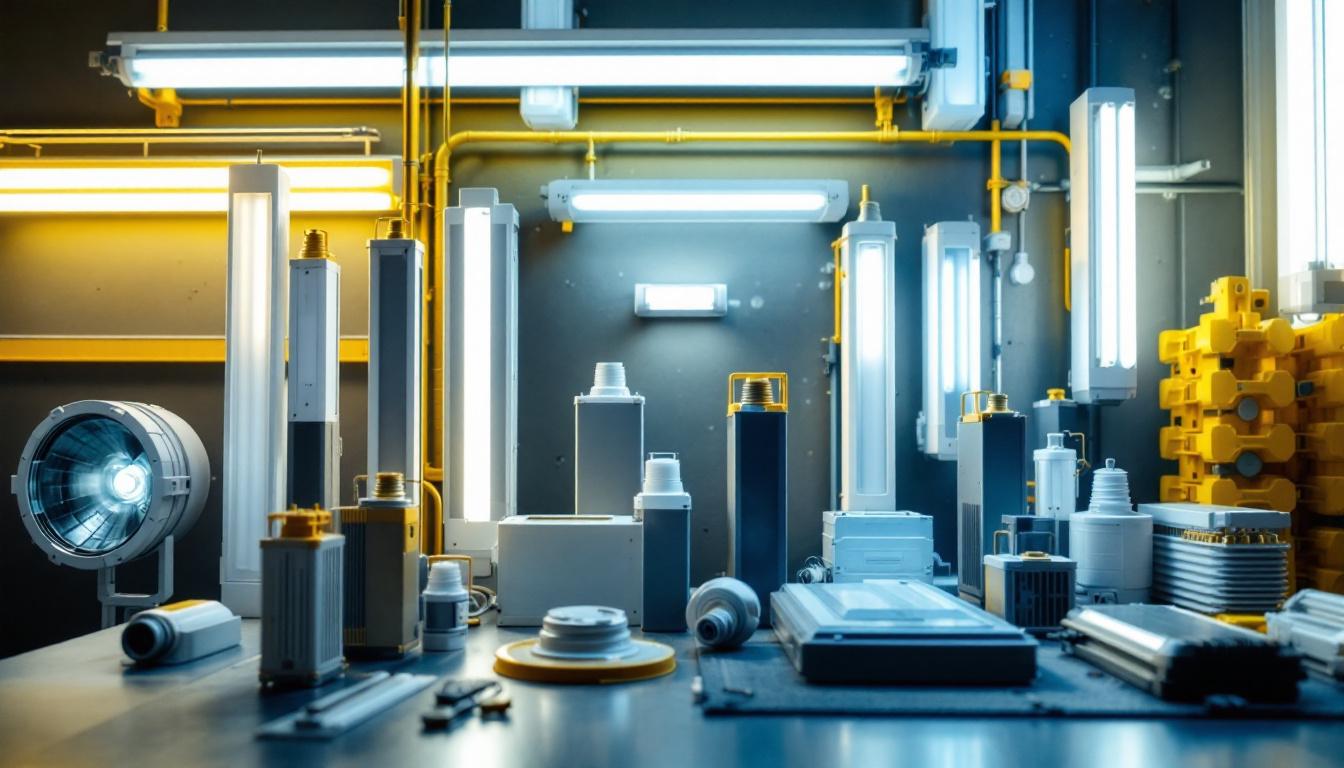
Fluorescent lighting systems are widely used in various applications, from commercial spaces to residential environments. At the heart of these systems lies the fluorescent ballast, a crucial component that regulates the current and voltage to the lamp. Understanding the different types of fluorescent ballasts and their importance in lighting installations can significantly impact the efficiency, performance, and longevity of the lighting system.
Fluorescent ballasts are electrical devices that provide the necessary starting voltage and limit the current flowing through the fluorescent lamp. They play a vital role in ensuring that the lamp operates efficiently and effectively. Without a proper ballast, fluorescent lamps would not function optimally, leading to flickering, reduced lifespan, and even failure.
There are two primary types of fluorescent ballasts: magnetic and electronic. Each type has its advantages and disadvantages, making it essential for lighting contractors to understand these differences when selecting ballasts for specific applications.
Magnetic ballasts have been around for decades and are known for their durability and reliability. They use electromagnetic induction to regulate the current in fluorescent lamps. Typically, these ballasts are heavier and bulkier than their electronic counterparts, but they offer several benefits that make them suitable for certain applications.
One of the main advantages of magnetic ballasts is their ability to work with a wide range of fluorescent lamp types. They are compatible with both T12 and T8 lamps, making them a versatile choice for various lighting installations. Additionally, magnetic ballasts tend to have a longer lifespan in certain conditions, particularly in environments with high humidity or extreme temperatures. Their robust construction often makes them less susceptible to damage from power surges, which can be a significant advantage in industrial settings where electrical fluctuations are common.
Electronic ballasts have gained popularity in recent years due to their efficiency and compact design. They use electronic circuitry to control the current and voltage supplied to the fluorescent lamp. This results in a more stable light output and reduced flickering, which can enhance the overall quality of the lighting.
One of the most significant benefits of electronic ballasts is their energy efficiency. They consume less power than magnetic ballasts, which can lead to lower energy costs over time. Additionally, electronic ballasts can operate multiple lamp types, including T5, T8, and T12, making them a flexible option for various lighting setups. Their lightweight design allows for easier installation and can reduce the overall weight load on fixtures, making them ideal for modern architectural designs that prioritize aesthetics and functionality.
Moreover, electronic ballasts often come equipped with advanced features such as dimming capabilities and programmable settings, allowing users to customize lighting levels based on specific needs or preferences. This adaptability not only enhances user comfort but also contributes to energy savings by allowing lights to be dimmed during off-peak hours or when natural light is sufficient. As the push for energy-efficient solutions continues, electronic ballasts are becoming increasingly favored in both residential and commercial applications, paving the way for smarter lighting systems that integrate seamlessly with modern technologies.
Selecting the appropriate ballast for a lighting installation is critical for several reasons. The right ballast can enhance energy efficiency, improve light quality, and extend the lifespan of the fluorescent lamps. Conversely, using an incompatible or substandard ballast can lead to various issues, including increased energy consumption, flickering lights, and premature lamp failure.
Energy efficiency is a significant concern for lighting contractors and their clients. Electronic ballasts, for instance, can reduce energy consumption by up to 30% compared to magnetic ballasts. This reduction not only lowers utility bills but also contributes to a more sustainable environment.
Moreover, energy-efficient ballasts can qualify for various rebates and incentives offered by utility companies, further enhancing the cost-effectiveness of the lighting installation. By choosing the right ballast, contractors can help their clients achieve significant savings while also promoting environmentally friendly practices. In addition, the long-term financial benefits of reduced energy consumption can be substantial, allowing businesses to allocate funds to other important areas, such as employee training or facility upgrades.
The quality of light produced by fluorescent lamps is heavily influenced by the ballast used. Electronic ballasts provide a more consistent and flicker-free light output, which can significantly enhance the visual comfort of a space. This is particularly important in environments where people spend long hours, such as offices, schools, and hospitals.
Furthermore, the color rendering index (CRI) of fluorescent lamps can be affected by the ballast. A higher CRI means that colors appear more vibrant and true to life. By selecting a high-quality ballast, contractors can ensure that the lighting not only meets functional requirements but also enhances the aesthetic appeal of the environment. This attention to detail can also improve productivity and mood, as well-lit spaces contribute to a more inviting atmosphere. In retail settings, for instance, the right ballast can make products look more appealing, ultimately influencing purchasing decisions.
Another crucial factor in selecting the right ballast is compatibility with the specific type of fluorescent lamps being used. Different lamps have unique electrical requirements, and using a ballast that does not match these specifications can lead to inefficiencies and failures. For example, some lamps may require a rapid-start ballast, while others may function better with a programmed-start ballast. Understanding these nuances allows contractors to make informed decisions that optimize performance.
Additionally, the lifespan of the ballast itself is an important consideration. High-quality electronic ballasts are designed to last longer than their magnetic counterparts, often exceeding 20,000 hours of operation. This longevity not only reduces the frequency of replacements but also minimizes maintenance costs and disruptions in the lighting system. In environments where consistent lighting is essential, such as in laboratories or production facilities, the reliability of a well-chosen ballast can be a game-changer, ensuring that operations run smoothly without unexpected interruptions.
Electronic ballasts come in various configurations and features, making it essential for contractors to understand the different types available. The choice of ballast can depend on factors such as lamp type, application, and specific project requirements.
Instant start ballasts are designed to provide a quick and efficient start to fluorescent lamps. They deliver a high voltage to ignite the lamp, allowing it to reach full brightness almost immediately. This type of ballast is particularly suitable for applications where lights are frequently turned on and off, such as in retail spaces or conference rooms.
However, one drawback of instant start ballasts is that they can shorten the lifespan of the lamp, especially if the lamps are frequently cycled on and off. Therefore, it is crucial to consider the specific usage patterns of the lighting installation when choosing this type of ballast.
Rapid start ballasts provide a more gradual ignition process for fluorescent lamps. They use a lower voltage to preheat the electrodes before igniting the lamp, resulting in a smoother start. This approach can help extend the lifespan of the lamp, making rapid start ballasts an excellent choice for applications where lights are left on for extended periods.
These ballasts are compatible with T8 and T12 lamps and are often used in commercial settings, such as offices and warehouses, where consistent lighting is essential. The gradual start feature also contributes to a more pleasant lighting experience, reducing the harshness associated with instant starts.
Programmed start ballasts are a more advanced option that offers a controlled ignition process for fluorescent lamps. They utilize microprocessor technology to manage the starting sequence, ensuring that the lamp is preheated before ignition. This results in a longer lifespan for the lamp and improved energy efficiency.
These ballasts are particularly beneficial in environments where lights are used for extended periods and require a reliable and consistent light output. While they may have a higher upfront cost compared to other types, the long-term savings in energy consumption and lamp replacement can make them a cost-effective choice.
When choosing a fluorescent ballast for a lighting installation, several factors should be considered to ensure optimal performance and efficiency. Understanding these factors can help contractors make informed decisions that align with their clients’ needs and project specifications.
One of the first considerations when selecting a ballast is its compatibility with the type of fluorescent lamp being used. Different ballasts are designed to work with specific lamp types, such as T5, T8, or T12. Ensuring compatibility is crucial to avoid issues such as flickering, reduced light output, or premature lamp failure.
Contractors should also consider the wattage of the lamps and ensure that the ballast is rated for the appropriate wattage. Using a ballast with the wrong wattage can lead to inefficiencies and potential damage to the lamp.
The intended application of the lighting installation plays a significant role in determining the appropriate ballast type. For example, areas with frequent on/off cycling may benefit from instant start ballasts, while spaces requiring consistent lighting may be better suited for rapid or programmed start ballasts.
Additionally, factors such as ambient temperature, humidity levels, and the presence of dimming controls should also be taken into account. Understanding the specific requirements of the application can help contractors select a ballast that meets performance expectations and enhances the overall lighting experience.
Energy efficiency is a critical factor in today’s lighting installations, and contractors should consider the long-term cost implications of their ballast choices. While electronic ballasts may have a higher initial cost, their energy-saving capabilities can lead to significant savings over time.
Moreover, contractors should be aware of any available rebates or incentives for energy-efficient lighting solutions. These financial incentives can help offset the initial investment and make energy-efficient ballasts a more attractive option for clients.
Fluorescent ballasts are a critical component of any fluorescent lighting installation. Understanding the different types of ballasts, their advantages, and their suitability for various applications is essential for lighting contractors. By selecting the right ballast, contractors can enhance energy efficiency, improve light quality, and extend the lifespan of fluorescent lamps.
As the lighting industry continues to evolve, staying informed about the latest advancements in ballast technology and energy efficiency will be crucial for contractors aiming to provide the best solutions for their clients. By prioritizing the selection of high-quality ballasts, contractors can ensure that their lighting installations are not only functional but also sustainable and cost-effective.
Ready to enhance your lighting installations with the highest quality fluorescent ballasts? Look no further than LumenWholesale. We provide contractors with spec-grade lighting products that meet the most rigorous industry standards. With our competitive wholesale prices and no middleman markups, you’re guaranteed to get the best value for your investment. Plus, our hassle-free bulk buying and free shipping mean you can stock up on reliable, high-performance lighting without any hidden fees. Elevate your lighting projects today by visiting Wholesale Lighting at the Best Value and experience the LumenWholesale difference.

Discover the crucial role of ceiling kitchen lighting fixtures for lighting contractors.

Discover how waterproof plugs can revolutionize your lighting projects and give you a competitive edge in securing more contracts.

Discover effective strategies to enhance your team’s skills in lighting with “Ceiling Light: How to Train Your Team in Lighting.” This article offers practical tips, innovative techniques, and expert insights to illuminate your team’s potential and elevate your projects to new heights..

Explore the essential considerations for lighting contractors when installing dock lighting.